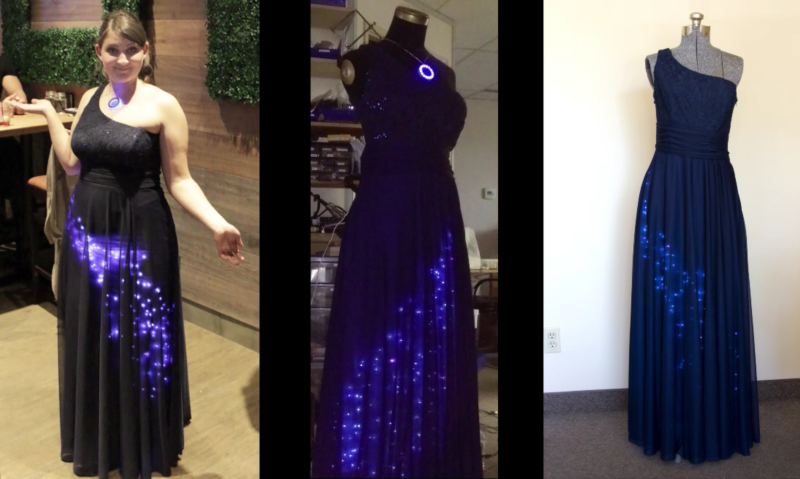[Dave Hrynkiw] wrote up some practical and useful detail around embedding electronics into clothing. It centers around his daughter’s “Starry Night” high school graduation dress, which is the culmination of a lot of experimentation in finding the best way to do things. His daughter accented the dress with LEDs to produce a twinkling starfield effect, and a laser-cut RGB pendant to match.
While [Dave] is the president of Solarbotics and pitches some products in the process of writing it all up, the post is full of genuinely useful tips that were all learned though practical use and experimentation. Imagine how awesome it must be growing up a child of a “local technology-hacking company” founder — akin to growing up as Willy Wonka’s progeny.
What advice does [Dave] have for making electronics an awesome part of garments? For example, the fact that regular hookup wire isn’t very well suited to embedding into clothing due to the need for high flexibility. There is also the concept of sequestering electronics into a separate Technology Layer — a must for anything that will be used more than once. The idea is to “build your technology so it can be isolated from the fashion aspect as much as possible. It makes building and maintenance of both the fashion and technology aspects much simpler.”
Slapping some LEDs and a battery pack into clothing might do the trick if all you care about is some bling, but if you want something that actually highlights and complements clothing while also being able to stand up to repeated use, this is a great read. A simple lighting effect that complements a design isn’t difficult, and there’s no need to reinvent the wheel or make the same mistakes others have encountered. Video is embedded below.
We love to see high-tech fashion that grows beyond simple “bling” effects, showcasing new ways to complement and highlight design — like this laser-cut, math-inspired dress that was modeled to fit the owner like a glove.















An interesting frock, to be sure. However, on an old replay of “I’ve Got A Secret” from 1961, Jane Powell was on
with a secret, “I’m wearing a dress with 500 lights in it,” or words to that effect. When the segment was over and
no one had guessed Jane’s “Secret”, the stage was darkened a bit and the dress was ‘turned on’ and she sort of
modeled it. It had a few types of blink patterns, and even in Black & White, it was an impressive display. One of
the individual lamps was shown and amounted to a rice grain with two VERY small wires sticking out of it. At
the time, (1961) they were the smallest lamps in the world. The manufacturer’s trade name was given but I don’t
remember it. A later lamp available to industry and hobbyists was called a ‘grain of wheat’ lamp. I think I may have
one or two of them around here.
This was, mind you, a decade or so before LEDs became common and about the same time-frame before any
MicroProcessors were on the shelves for purchase.
The “Technology Grad Dress” is indeed impressive, but certainly not an original idea. Certainly more advanced!
Jane Powell is still with us and is exactly 10 years my senior. (We share the April Fool’s Day birthday.) She was
always a most attractive woman and today probably still gets many ‘second looks’ out in public. I know I would
certainly ‘look twice!’
I used some of those grain of wheat lamps in a science fair project… which I completed with the help of my dad around 1997 or so.
We had a few electronics demo’s on it and and explained resistance, and current with a split graphite pencil acting as a potentiometer with the grain of wheat lamp connected in series with it. It wasn’t particularly complex but it did win our homeschool groups science fair.
I do remember that it used 6v flashlight batteries and also a knife switch which powered the whole thing on or off.
Probably my first real experience with electronics after which I got an Elenco 50 in 1 electronics lab and promptly blew up the germanium diode… in a bright flash even.
Lovely. A great application of technology and art.
she is ready for the hungery games
“Input-impedance matching on the first LED from the microcontroller is proving to be quite necessary, as we were overdriving the signal to this first LED and making it go *poof*. ”
Please explain. What impedance does a 560 ohm resistor match?
I like the use of two layers for durabilty and making it (tremendously) easier to clean. For what it’s worth, I’ve adopted a stage costumer tactic of cleaning wearables by spraying them with a 50/50 mix of water and the absolut crappiest vodka I can find (see what I did there?). https://secretundergroundlaboratory.wordpress.com/2015/04/27/real-life-pac-person/
Learned about that technique only recently. Sent out the Grad dress for dry cleaning (paying extra for special sequin care), and had it come back sequin-less… Sigh. Yes, I think the Vodka trick would have been much smarter move!
So the layer worn against your sweaty, oily skin is the layer which is NOT cleaned?
Isn’t that like washing your tie, jacket and shoes, but not ever washing your underwear?
seems like spraying the dirty parts, wherever they might be, is sort of implied
That’s a really cool dress and love how it has a matching necklace. Seeing so many clothes hacks lately has my appetite to try it building.
Have an old implementation of improved perlin noise I spent months optimizing for old graphics hardware (shader model 2.0). Would very likely run just as well on a pi or similar small computer board for hundreds or possibly thousands of samples. I imagine sampling that algorithm with coordinates derived from GPS and accelerometer sensor, smoothly interpolating the results to LEDs against soft diffusing pads woven into a shirt. Procedural generated shirt textures could become a fun thing.